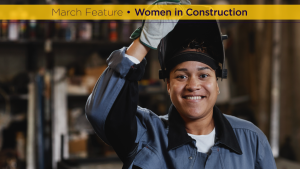Prior to COVID-19, manufacturing, construction and other trades were focused on recruiting women to the sector, but since the crisis hit that has become more difficult due to what economists are calling the “she-cession.”
“If we talked a couple of months ago, I would have had some really great news to share,” said Rhonda Barnet, president and COO of AVIT Manufacturing, formerly Steelworks Design, an engineering and custom automation firm in Peterborough, Ont.
She was the speaker at a recent Women Mean Business webinar held June 9.
“Right now we’re finishing our thoughts on the health crisis and looking to the economic crisis. What we are realizing in our country and around the world is that women have been greater impacted in this recession than men and economists are talking about this period as the ‘she-cession.’ ”
While women represent 48 per cent of the workforce in Canada, they represent only 28 per cent of the manufacturing labour force and that figure has been stagnant for 30 years, explained Barnet, who was appointed the first female chair in history of Canadian Manufacturers and Exporters (CME) from 2016 to 2018 and is still with the organization.
Things were looking positive for the sector just prior to the pandemic with women representing 29.5 per cent of the labour pool.
“That’s really interesting because what we know statistically is if we can move the dial over 30 per cent things really start to rebalance themselves. We were so close to 30 per cent and then COVID happened,” Barnet explained. “Schools shuttered and daycares shuttered and guess what? Women were more disadvantaged in needing to leave their job to take care of their kids, to take of their seniors, to take care of all these people once again. That is why a lot of people are now calling this period the she-cession.
“By mid-May the representation of women in the sector in Canada dropped to 26.9 per cent,” she added.
“Now we’re below historical levels on a representation basis, so we’ve got our work cut out for us. A lot of the work that I’ve been doing is to really move the dial and make a difference.”
Prior to COVID, Barnet spent a lot of time talking about the labour shortage in the trades and encouraging young women to consider a career in science, technology/trades, engineering and math (STEM).
“When I talk about STEM I always include the trades,” Barnet said. “Women are grossly underrepresented in our country, in most countries, and we need to do something about it. If we want to fill the pipeline down the road with more technical women in manufacturing, we need to start really young. We need a lot of our work to focus on broadening the minds of young girls and women so they can see their way to successful careers in any trades and technology field like construction, like manufacturing.
“We are educating our young girls but we are not doing enough to create the linkages to these really interesting trades and technology sectors.”
In 2018 Barnet launched CME’s We Can Do It campaign, an initiative funded in part by the federal government to add 100,000 women to the manufacturing workforce over the next five years.
“Amazingly in one-and-a-half years we added 40,000 net new jobs for women in the sector,” she said. “We have a government that is really promoting the value of women in the workplace. We have some really great programs running here in the country.”
Her philosophy is, “if you can see me, you can be me.”
She is big believer in mentorship and empowering women to get into leadership roles.
“We have to get people into the ranks of our industries if we want them to be future leaders,” she noted. “Diversity breeds innovation, productivity, profitability. It’s hard work at first to bring together diverse views, opinions and thoughts but when we do it and we do it right we have an advantage…that’s what we need to build in our sector.”
A lot of information and tools can be found on the CME website womeninmanufacturing.ca.
“It has a manufacturing lens to it but also has a lens for male-dominated industry and making a difference around diversity and inclusion,” said Barnet. “It can be adopted by the construction industry and various other industries where women are grossly underrepresented.
“It’s not just a women’s movement, men are a big factor in the change that needs to take place.”
Follow the author on Twitter @DCN_Angela.











It is time for the Province to step up to the plate and play ball,
we need incentives like tax credits, lets get creative on inviting
more apprenticeships for good paying jobs with benefits.